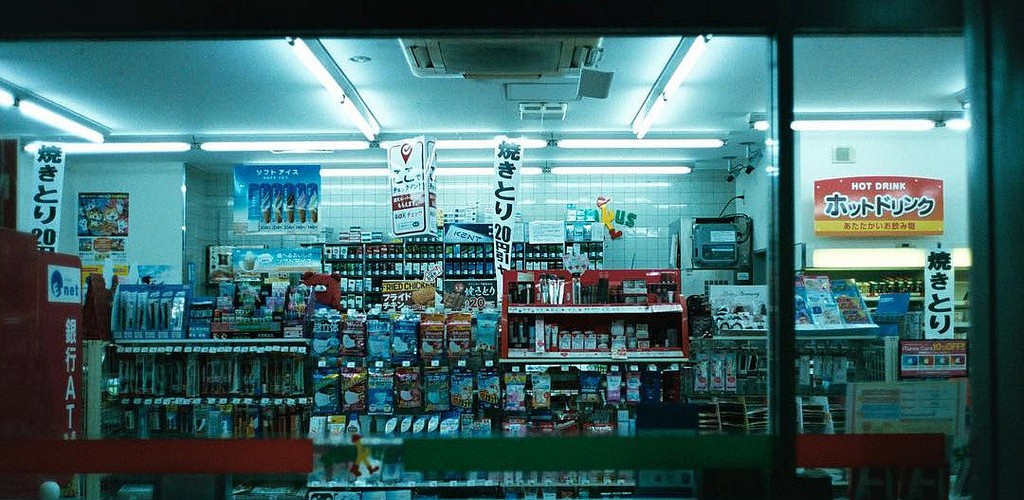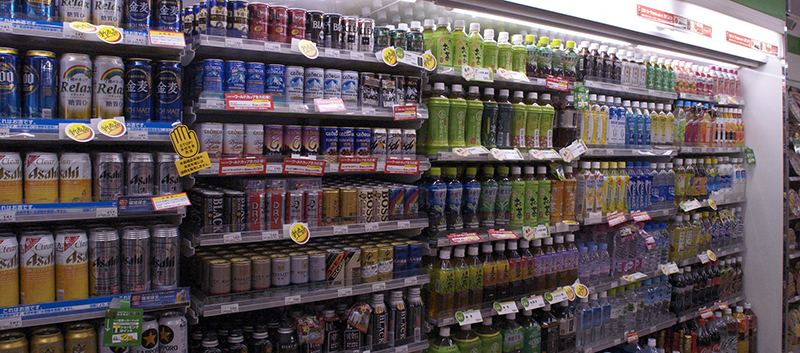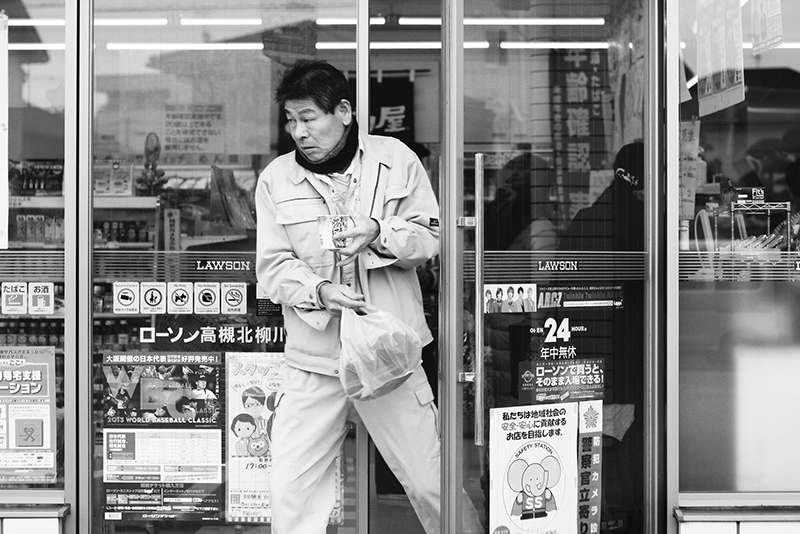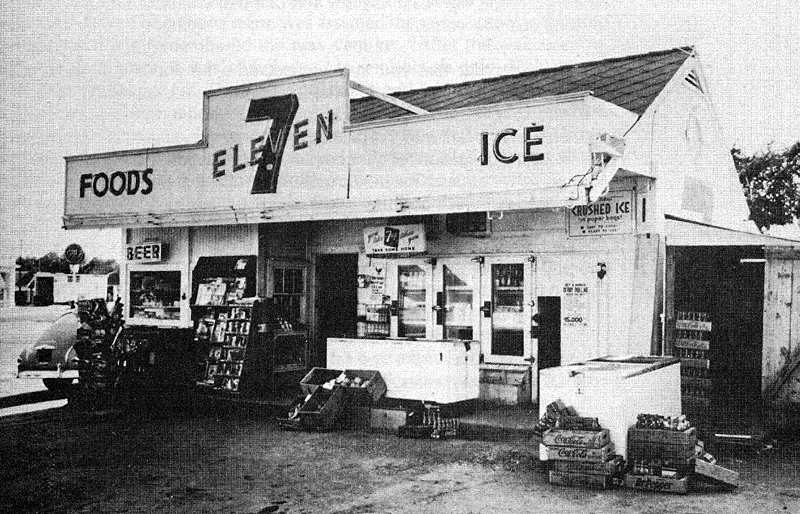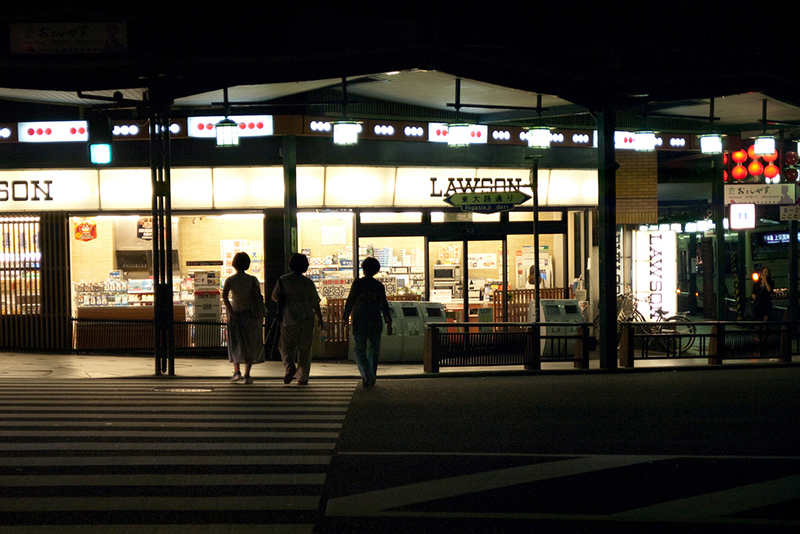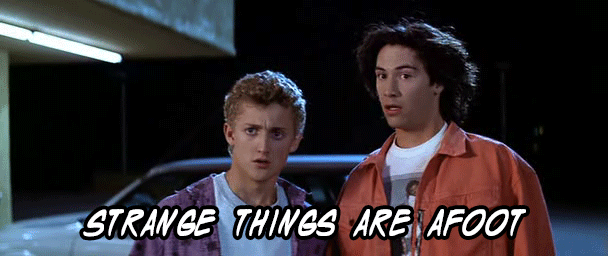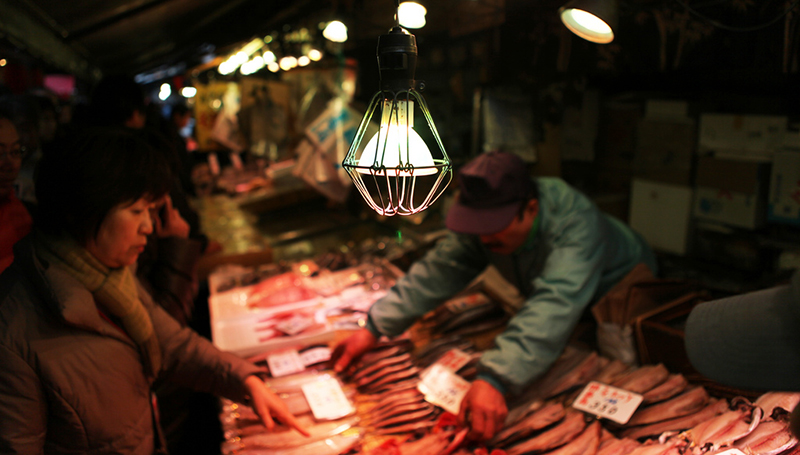At 10:30 on Monday night, six young office workers sat at a table outside of FamilyMart, eating snacks and drinking chūhai. As a sticker someone slapped on a nearby wall said: “Be Alive in Kyoto.” They certainly were. My wife Rebekah and I had come to Japan on our honeymoon. She’s passed out early in the hotel this night, so I went out alone. I wanted to live, and FamilyMart was just a block away.
The thing about Japanese convenience stores is that they’re awesome. Called conbini, sometimes spelled konbini, Americans won’t believe this, but conbini are respectable social centers that serve high quality packaged and delicious fresh food that you actually want to eat, rather than avoid. Open 24 hours, three main chains dominate 90% of the Japanese marketplace: 7-Eleven, Lawson, and Family Mart, with Ministop, Daily Yamazaki, Seico, Poplar, and Circle K Sunkus making up the rest. Around 55,000 conbini operate in Japan. Mostly a get-it-and-go operation, you buy your crisp, cheese-stuffed croquettes, spongy green tea cream roll and egg salad sandwich to take to work or the park or home. Some stores provide a few stools by a counter so customers can eat inside, maybe a few small tables, but space is tight and expensive in urban Japan. Where many rural and suburban convenience stores have enough property to dedicate to outside seating or parking, fewer stores in the centers of large dense cities like Tokyo, Osaka, and Kyoto do. Somehow this FamilyMart in central Kyoto had enough room to provide five round, white plastic tables out front for customers. It was the space that would be a parking lot in America.
A brief rain left the summer air moist and cool. Sopping rainwater with some napkins, I sat myself at a table next to the group and laid out my dinner of a four-dollar bowl of microwaved curry, a Hitachi Nest beer, and the only candy bar I’ve ever fallen in love with as an adult: Asahi’s Ippon Manzoku, which is a flavorful airy mixture of toasted rice, raisins, and nuts enrobed in dark bitter chocolate, marketed as a health bar. I also bought a small 180-milliliter bottle of Yoichi single malt whisky for later, because they don’t sell this revered Japanese malt in the U.S., yet I could pocket a bottle here on any corner for 11 bucks. You couldn’t beat it. In typical Japanese fashion, the factory that made the curry sealed the plastic container in thin Saran wrap, which the cashier then placed in a plastic to-go bag that I told him I didn’t need because I was only going to eat it 15 feet from the register. “Arigatou,” the clerk said, handing me the bag. As I undid the layers of excessive packaging, the group of friends smoked and laughed and reached into bags of FamilyMart brand chips and chocolate-covered pretzels that spread across their table within everyone’s reach. They were having an after-work party.
The women wore dark suit pants and jackets. The men wore dark ties over light collared long-sleeve shirts, with nice zip-top canvas bags leaning against the table by their leather shoes. Instead of going home to rest for tomorrow’s workday, these 30-somethings came here to live it up. They tapped cigarettes’ ashes into an empty chūhai can, tipped back their Takara tallboys, and used disposable chopsticks to pick sardines from a tin in the center of the table. Chūhai is a Japanese highball. Made from shōchū rice wine, fruit, and carbonated water, shōchū is the “chū” to the highball’s “hi.” Canned versions are sold everywhere, from vending machines to grocers, and taste too metallic for my palate. They are around 8% alcohol, though, which is 3% more than the average Japanese beer, and just enough to expel thoughts of tomorrow’s workday from your mind.
While I spooned curry, the three men kept lighting new cigarettes. The women didn’t smoke; wisely, they just ate and drank. One of the men was loud and drunk. He pushed his hair back with this fingers, pressed his palm down on the table to make his points, and did most of the talking. Hamming for his captive audience, he clearly thought he was hilarious, gesturing and talking constantly, his eyes narrowing when he leaned down low and stared at his companions, waiting for a reaction. The others laughed at his jokes and sipped their cans, nodding and giving him room to perform. I drank my beer and watched enviously, wishing, despite the one guy, that I could sit with them and join the fun, or even understand what they were talking about. Mostly, I wished I could hang at the conbini any time the way they could.
Thanks to intense competition and a dedication to quality over crap, the main chains serve excellent bento, sushi, salads, and matcha lattes priced much lower than their flavor’s worth. The traditional simmered working-class food called oden is good enough that it deserves a fancier steam tray than the one it sits in by the cash register. Store shelves are filled with quality Japanese Miyagikyo and Yoichi single malt whisky alongside the necessary cheap mixers, serviceable sake, and more beer than a whole high school party would need. The Häagen-Dazs purple yam ice cream is worth every calorie, and you won’t regret eating that decadent, inexpensive pot de crème type thing with burnt brown sugar syrup on the bottom while drunk late at night. Don’t expect overcooked corndogs and taquitos scorched by heat-lamps. What would be shameful drunk food in America somehow tastes excellent here. Sure, the onigiri are no frills, but they’re just rice, seaweed, and filling anyway; what do you expect? At least they’re healthy. The miracle is that they’re cheap but don’t taste it, because conbini themselves reflect Japan’s insistence on doing even simple things way above average, which is nothing you’d say of American convenience stores where many of us gas up and grab a Slim Jim out of desperation rather than preference. And many conbini foods don’t just have suggested sell-by dates. They have sell-by times, and if you try to grab a sandwich that’s 20 minutes past its time but hasn’t yet gotten replaced, staff might run in back to grab you a fresh one.
7-Eleven has 17,799 stores in Japan, and FamilyMart over 10,000, but I feel like I saw most of those in Kyoto alone, some on the same block. They’re literally everywhere — a FamilyMart across from a Lawson one block from another FamilyMart. In the mornings, people stand outside of them sucking down cigarettes and guzzling canned coffee before work. After dark, troupes of young girls browse the cold cases, trying to decide which cake or creamy custard would end their night best. Single men carry home plastic bags heavy with beer, soda, and milk, while confused gaijin just off the plane wander the aisles, overwhelmed by options and not sure what everything is. Some people have allegiances to a particular chain, claiming one company has better desserts or sandwiches, and another makes better fresh coffee or juicier fried chicken. (Fact: Lawson makes the best fried chicken.) Most sell exclusive items (for instance, Lawson’s red “Kara-age Kun chicken” which, once again, is the best) and run specials to differentiate themselves (like Lawson’s Wasanbon Syrup Anmitsu dessert, or Sunkus’s Salted Caramel and Banana Mountain Cake). Even visitors will form loyalties. 7-Eleven is one of the few places in Japan whose ATMs dispense cash from foreign debit cards, and your relief at the sight of its green, orange, and red sign will be so great that it will elicit a Pavlovian feel good response, because the thing is, as a visitor, you’ll eventually need conbinis, and their snacks and considerate service will make you grateful for that.
The part of central Kyoto where Rebekah and I were staying, off Karasuma Avenue just below Shijō-dōri, was filled with tiny bars, yakitori joints, and busy izakayas, and yet, on this night, I chose FamilyMart. Rebekah and I had feasted on many of the city’s outstanding salt-of-the-earth restaurants over the last few days, so now I wanted to experience something distinctly Japanese that went against everything I knew and assumed, something loved by the locals and that, like Bigfoot, was still hard to believe in: a memorable, relaxing dinner at a convenience store — a phenomenon you might call conbini life.
•
The world’s first convenience store started in 1927 in a part of Dallas, Texas called Oak Cliff. A retail store named Southland Ice Dock sold foot-long blocks of ice from a small building, so people could refrigerate their food. Before home refrigerators became widespread, people used iceboxes to store perishable items, and they bought block ice from door-to-door salesmen or commercial manufacturers. Grocery stores closed early, but demand for ice remained high at night in the Texas heat, so “Uncle Johnny” Jefferson Green, the Dock’s manager, captured that business by staying open for 16 hours a day, seven days a week, including Sundays when many grocers closed. Since customers came at all hours, he decided to sell them staples like eggs, bread, and milk, too. The store’s parent company, Southland Corporation, noticed Uncle Johnny’s success. One of the company’s founders, Joe C. Thompson, Jr., imagined various applications for this new business model, so Thompson started offering the same staple foods at some of the company’s other 21 Texas Ice Docks. 10 years later, they increased to 60 Southland Ice Docks.
In 1928, Southland started selling gas, too. Cars were getting popular, and the company recognized drivers as a new market. Southland built their stores 60 feet from the street, so cars could pull up and drive away easily. The business was novel, so curious drivers came to try it. It was also highly functional, so it caught on. By 1936, Southland Ice Docks expanded their retail offerings by adding more staples, canned food, and watermelon, when it was in season, which they kept cool on ice. Combining a grocer with an ice house with a gas station, Southland named their new one-stop shops Tote’m, which played on the way customers “toted” away their purchases, and unconsciously reflected a fascination with, and appropriation of, the American frontier and Native American culture in the early 20th century West. Back then in the Sunbelt, you had your Teepee hotels, your Wagon Wheel hotels and your Tomahawk inns. In 1946, Tote’m changed their name to 7-Eleven to incorporate one of their most distinctive offerings: their 7 AM to 11 PM hours. By the 1950s, 7-Eleven opened locations in other states, and as the American suburbs expanded, so did their business, often penetrating into small or outlying residential areas that didn’t have a large grocer. By 1963, 7-Eleven had 1,000 stores.
As The Atlantic describes, when 7-Eleven went 24/7 that same year, it was by accident. “[F]ollowing a football game at the University of Texas, customers flooded the 7-Eleven in Austin. “It couldn’t close,” notes the company’s website. The store stayed open all night. So successful was the inadvertent model that always-open 7-Elevens began to crop up intentionally; the first all-night outpost, perhaps unsurprisingly, was in Las Vegas. 7-Eleven’s beloved Slurpee drinks and Big Gulps came later, creating a unique set of iconic offerings that gave the brand an edge over the competition, and cemented their standing in the market, rather than just their place in retail history.
Just as Southland had built their new empire off of Uncle Johnny’s little idea, other people copied 7-Eleven’s model during the 1960s and ’70s in order to replicate its success in regional markets. There was Speedee Mart in Southern, California, Mac’s in Ontario, Canada, Kwik Stop in Kansas, Lawson in Ohio, Plaid Pantry in Oregon, and countless others too small and too short-lived to have left a lasting mark. The Southland Corporation bought Speedee Mart to turn into 7-Eleven during its nationwide expansion. With stores already in Canada and Mexico, 7-Eleven’s parent company, Southland Corporation, teamed up with the Japanese grocer and retailer Ito-Yokado and opened Japan’s first 7-Eleven, the Toyosu Store, in the Koto area of Tokyo in May, 1974. The thing is, Japan already had a convenience store.
In September 1973, the Seiyu department and grocery store chain opened a small convenience store in Sayama, a city in the sprawling western suburbs of the greater Tokyo area. The little store was an experiment. Seiyu was testing the mini-grocery model. In 1978, after Seiyu’s successful trial run, they created what they called the FamilyMart Department and opened three more FamilyMart stores. Japan’s mini-mart market was wide open, and although FamilyMart and 7-Eleven didn’t multiply at quite the same pace, they both grew quickly to take advantage of how ripe it was for exploitation. 7-Eleven might be the home of Big Bite hotdogs and beef jerky in America, but in Japan, conbini succeeded partly by adapting traditional Japanese foods like oden, bento, and onigiri for the grab-and-go format, and winning people over to this new mode of business.
By 1976, 7-Eleven had 100 Japanese stores. By 1980, 7-Eleven had 1,000 stores. By 1990, it had 4,000 stores, 9,000 by 2002, and over 18,000 by 2016, making it Japan’s largest conbini chain.
By 1981, FamilyMart formed a corporation, and expanded from four to 89 stores. By 1990, FamilyMart had stores in Taiwan and South Korea. It opened its 10,000th store in 2013, and became Japan’s third largest conbini. Interestingly, another American company, called Lawson, became Japan’s second largest.
In 1939, dairy farmer James “J.J.” Lawson opened the small Lawson’s Milk Company shop inside his Cuyahoga Falls dairy facility to sell his milk directly to customers. Over the years, Lawson’s Milk branched into a series of Ohio convenience stores, changed hands a few times, was renamed Dairy Mart, and then converted to Circle Ks, which erased nearly all evidence of its existence in America. By then, it had been transplanted to Japan by its parent company. Japan’s first Lawson opened in Toyonaka City, outside of Osaka, in June, 1975. Two years later, they abandoned their diurnal limitations and went 24 hours. According to their corporate history, “The first store sold party foods on an American theme and was very different from the Lawson stores of today.” Although it’s unclear what “party food on an American theme” means, Lawson’s current conbini format truly started in September of that year when they opened their first franchised location, what they call the “Momoyama Store.”
Emblazoned with a simple white milk bottle logo set against a powder blue background, the Lawson sign’s pastoral simplicity and rural Americanness might seem out of sync with the flashing, buzzing intensity of Japanese signage, but the logo has became an inseparable part of the Japanese landscape, like Shinto shrines, kimono and tsugi, and Tommy Lee Jones’s face on BOSS coffee advertisements. Lawson’s logo communicates simplicity and calm, something pure and traditional in a busy, modern country filled with fast trains and crisscrossing wires. The sign has a calming effect, a bit like mother’s milk, which seems fitting, though who would have imagined that a milk company from rural Ohio would one day have its headquarters in a skyscraper in Tokyo?
By some estimates, Japan now has over 50,000 conbini, or one store for every 3,400 people. I never thought I’d hear myself say this, but I wish America had that many, too — but not the ones I’m used to.
•
Like many Americans, I lived my young life on the convenience store stage, though my gaijin stores were inferior versions.
I grew up in scorching Phoenix, Arizona, where air conditioning saves lives and hydration comes fizzing in 44-ounce soda cups. Circle K and 7-Eleven ruled my homeland, most of them flanked by parking lots so huge that you could roll your supertanker fountain drinks out to your giant car in a wheelbarrow if you needed to. Before my teenage friends and I drove, we hung out at these places. When we got bored at home, we’d skate there to get drinks. We’d sit on our boards out front. We’d eat hotdogs and chew gum, finding shelter from the summer sun up against the front windows or beside the ice machine, where we’d eyeball girls as they came and went, posturing and depraved, talking to none. The convenience stores that had video games were our favorite ones, and we got to know the landscapes based on which games they had.
I never had a favorite, but I gravitated to 7-Eleven the most. Only as an adult did I recognize why: I liked its color scheme. Having been raised during the late ’70s and early ’80s, the era of ugly combos like mustard yellow on orange on brown, something about 7-Eleven’s green, orange, and red coloring felt unconsciously comforting. Sometimes staff shoed us away, but mostly, we hung out, immune to the heat by stupidity and youth, and when the inevitable boredom set back in, we left. We were bored when we got there. That’s why we went in the first place.
As we got older, we went to convenience stores to fish for beer. “Fishing” is the process where underage kids ask complete strangers to buy them alcohol, based on the logic that if you throw out a wide enough net frequently enough, you’ll pull one willing participant in. We did. Weekend after weekend, sympathetic enablers bought us 40-ounce bottles of malt liquor or cheap 12-packs of Milwaukee’s Best. We played on their sympathies. Some wanted to seem cool to cool young people; some wanted us to have as much fun as they had in their youth; and some probably malevolently wanted to get us in some sort of drunk trouble, hoping that if we got sick enough, we’d quit asking people for beer. We did not. We got the beer, and even when we did get sick, we loved convenience stores for it. We were shocked how easy it was. People said no, but no one gave us trouble. One time I asked a guy if he’d buy us beer, though, and he smiled. “I would,” he said, “but — ” Then he unbuttoned his collared shirt, revealing a giant gold Phoenix police badge icon on a black t-shirt. “Sorry,” he said. We kept going back for more.
Once some of my friends got cars, we focused our high school nightlife on a particular Mobil gas station. A friend worked there, so we haunted the place on Friday and Saturday nights. It wasn’t much: just a single small building standing inside a parking lot. It didn’t have a convenience store like other gas stations. It didn’t even have a single tree. This was essentially a service station with a cash register, two coolers that contained sodas, water, and beer, and a selection of cigarettes, which we smoked with abandon. During the day the station did tune-ups, oil changes, rotations, and minor repairs, but our friend just worked the register. We’d park our cars along the back of the lot at night, along a low wall that separated the station from the public park behind it, we’d hide our empty beer bottles in a large dumpster, and we’d smoke and talk and try to figure out what else to do: Was so-and-so having people over? I heard her parents were out of town. Want to go to that party in Tempe? For sure, but first we had to wait for so-and-so to get ready. And get pizza. There was always more pizza. Sad as it sounds, this gas station briefly became our second home, the center of our social lives during the years when we lacked own apartments and better night life options, and it functioned as the centralized location where our friends met before going to more exciting events. Despite its thin offerings, we loved it. It did more than work. It endeared itself to us. One of the first times my friends and I tripped on acid, we stared too long at our sweaty pock-marked faces in the bathroom mirror — a common LSD mistake. We ate mushrooms in the neighboring park and lost ourselves there, as if it was a sprawling oasis, as the white intense light of the Mobil station glowed in the distance, keeping us grounded as a cardinal direction and watching over us as we fell apart. Since our friend worked the night shift, no one complained about our presence or strange behavior, and we could stay as long as we liked. He didn’t mind. Companionship made his shift go faster. As welcome as we felt, we never thought Mobil was a great choice. On the contrary, we felt like losers settling for a convenience store. But we couldn’t go to bars. We didn’t have apartments. We knew something much better was waiting for us after this awkward phase, and when that time finally came, we abandoned the gas station and never looked back. Yet in Japan, there didn’t seem to be the same shame. Adults hung out at conbinis contentedly, eating, smoking, drinking. Beside the food, maybe part of my love of the Japanese convenience store comes from my experience of the lesser American ones, and the envy which arises from having gotten the shorter end of the stick. It’s like “Wow, if I’d grown up here, look at great things could have been!”
American stores never try to impress or woo you the way Japanese stores do. American chains know your standards are low, that you‘ll trade taste and quality for price and convenience, that you don‘t expect much more than the salted fat drug on your tongue, so they don‘t provide much. You like shit? Well, here’s your shit. Japanese stores do the opposite. They actually respect their customers and invite them to hang out there.
Conbini have not only succeeded, but made a place for themselves in the culture, because they cater to the Japanese lifestyle as much as to tastes. Unlike people in America and other countries who have big home pantries and often shop for a week’s worth of groceries at a time, the Japanese traditionally buy what they need each day, sometimes each morning. Limited storage space in apartments means people don’t stockpile as much food as Americans beyond things like rice, tea, and spices that have a longer shelf-life. The fact that the Japanese have traditionally cooked fresh fish and vegetables means they’re used to buying perishable items daily. They don’t necessarily think of it as inconvenient — it’s part of their daily life. Also, because homes are often too small to entertain, people in urban Japan eat out a lot and use cafes, restaurants and bars as their social centers, so they don’t need as many groceries on hand.
In Kyoto that night, those business people sat outside and drank, but not to excess. They smoked, though no more than you would in a Japanese bar. And they snacked, which is an inseparable part of Japanese drinking culture; after all, an izakaya is a bar that serves food, not the other way around. This was their night life, their restaurant, their bar. Conbinis are smart to compete with bars with this business model: sell the snacks and alcohol, and a someplace nice outside to consume them.
The office workers had shoved their to-go bags under their cans and bags of chips to keep them from blowing away, and the arrangement of bags atop bags looked more like a metaphor for the high environmental cost of convenience than a simple act. After I’d scraped the last bits of curry from the bottom of my bowl, I gathered all the waste from my meal to one side of my table in order to marvel at the amount required to create it. The plastic bowl, the factory Saran wrap, the FamilyMart to-go bag that I hadn’t wanted, along with napkins, receipts, beer bottle, candy bar wrapper, chopsticks, plastic fork, knife and spoon, of which I only used the spoon, all of which I threw in the trash 30 minutes after buying it. That’s a lot of packaging for a small utilitarian meal. As a environmentalist, I couldn’t help but wonder what percentage of the Pacific trash gyre came from Japanese conbini packaging. This system couldn’t be sustainable. And yet, I sat there envying everyone who could do this exact thing every week. Customers drove up on mopeds. They rode up on bikes. They walked off carrying crinkly bags of late-night snacks and beer down the street, and I froze this moment in my mind to take back home with me.
When two of the women got up to leave, the drunk ham wouldn’t let them. After they bowed, he tried to give one woman some a small bag of chips, but she declined. Drunkenly, he insisted. Again, she declined. As the women left, the dude danced over to them, shimmying on the sides of his feet in what you might call a sachet, and finally forced the snack into her hand. The women bowed and left. At 11:10 pm, I finally left, too. I walked half a block down the street to my hotel and climbed into my hard tiny bed, excited to tell Rebekah at breakfast about my blissfully benign night outside the conbini. I never felt brand loyalty to convenience stores back home, but after my first trip to Japan, I used to think of myself a Lawson man. I liked its logo best. After this second trip, though, FamilyMart won my heart and I’ve grown to love it and Lawson equally. Not that it matters. There aren’t any FamilyMarts or Lawsons in the continental US. Our convenience stores suck. I never shop at them, unless I run out of toilet paper, and even then, I go reluctantly. •
Feature image courtesy of Israel via Flickr. Article photos courtesy of Staffan Asami, japanexperterna.se, Roadside Pictures, inkelv, and Evan Blaser via Flickr (Creative Commons).
